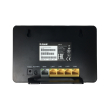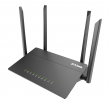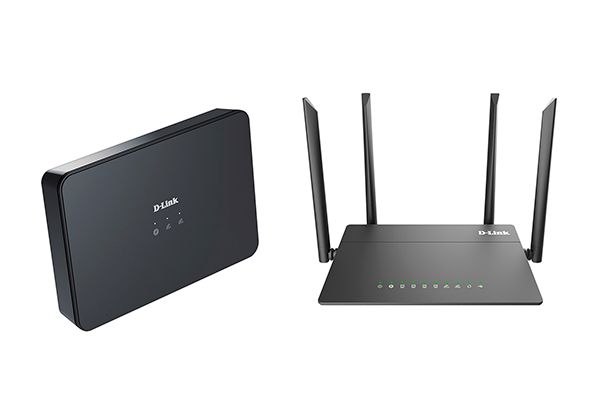
DIR-815
AC1200 Wave 2 MU-MIMO Wi-Fi EasyMesh Router with 3G/LTE Support and USB Port
Description
USB Port1
The router is equipped with a USB port for connecting a USB modem, which can be used to establish connection to the Internet. In addition, to the USB port of the router you can connect a USB storage device, which will be used as a network drive, or a printer.
In order to use the multifunction USB port effectively, the router supports simultaneous operation of several USB devices. For example, you can access multimedia content of the connected HDD storage and at the same time share a USB printer.2
Wireless Interface
Using the DIR-815 device, you are able to quickly create a high-speed wireless network at home or in your office, which lets computers and mobile devices access the Internet virtually anywhere (within the operational range of your wireless network). Simultaneous activity of 2.4GHz band and 5GHz band allows performing a wide range of tasks. The router can operate as a base station for connecting wireless devices of the standards 802.11a, 802.11b, 802.11g, 802.11n, and 802.11ac (at the wireless connection rate up to 1167Mbps3).
Secure Wireless Connection
The router supports multiple functions for the wireless interface: several security standards (WEP, WPA/WPA2/WPA34), MAC address filtering, WPS, WMM.
In addition, the device is equipped with a button for switching the Wi-Fi network off/on. If needed, for example, when you leave home, you can easily switch the router’s WLAN by pressing the button, and devices connected to the LAN ports of the router will stay online.1
Advanced Capabilities of Wireless Network
The EasyMesh function1 is D-Link implementation of mesh networks designed to quickly connect several5 devices into one transport network, for example, when it's required to provide high-quality Wi-Fi coverage without dead zones in living units of complicated planning or it's needed to create a large temporary Wi-Fi network for an outdoor event.
Multi-user MIMO technology allows to distribute the router's resources to let multiple wireless clients use the Wi-Fi network efficiently, keeping high rates for HD media streaming, lag-free gaming, and fast transfer of large files.
Transmit Beamforming technology allows to flexibly change the antennas' radiation pattern and to redistribute the signal directly to wireless devices connected to the router.
Smart adjustment of Wi-Fi clients6 is useful for networks based on several D-Link access points or routers – when the smart adjustment function is configured on each of them, a client always connects to the access point (router) with the highest signal level.
Support of guest Wi-Fi network allows you to create a separate wireless network with individual security settings and maximum rate limitation. Devices connected to the guest network will be able to access the Internet, but will be isolated from the devices and resources of the router's LAN.
4-port Switch
The built-in 4-port switch enables you to connect Ethernet-enabled computers, game consoles, and other devices to your network.
Security
The wireless router DIR-815 includes a built-in firewall. The advanced security functions minimize threats of hacker attacks, prevent unwanted intrusions to your network, and block access to unwanted websites for users of your LAN.
The SSH protocol1 support provides more secure remote configuration and management of the router due to encryption of all transmitted traffic, including passwords.
In addition, the router supports IPsec and allows to create secure VPN tunnels. Support of the IKEv2 protocol1 allows to provide simplified message exchange and use asymmetric authentication engine upon configuration of an IPsec tunnel.
The router also supports the SkyDNS web content filtering service1, which provides more settings and opportunities for safer Internet experience for home users of all ages and for professional activities of corporate users.
Now the schedules7 are also implemented; they can be applied to the rules and settings of the firewall and used to reboot the router at the specified time or every specified time period, to automatically save the configuration of the router to a connected USB storage, to set rules for limitation of wireless client maximum bandwidth, and to enable/disable the wireless network and the Wi-Fi filter.
Easy Configuration and Update
You can configure the settings of the wireless router DIR-815 via the user-friendly web-based interface (the interface is available in two languages – in Russian and in English).
The configuration wizard allows you to quickly switch DIR-815 to one of the following modes: router (for connection to a wired or wireless ISP), access point, repeater, or client, and then configure all needed setting for operation in the selected mode in several simple steps.
Also DIR-815 supports configuration and management via mobile application for Android smartphones.
You can simply update the firmware: the router itself finds approved firmware on D-Link update server and notifies when ready to install it.
1Only for DIR-815/R4.
2When using a USB hub with external power supply.
3Up to 300Mbps for 2.4GHz and up to 867Mbps for 5GHz.
4WPA3 is available only for DIR-815/R4.
5Up to 6 devices. Cooperation is supported for the following models: DIR-X1530/A1, DIR-X1510/R1, DIR-842V2/A1, DIR-842/R7, DIR-842/R5, DIR-842/S2, DIR-842/S1, DIR-842/R4, DIR-830M/A1, DIR-825/R7, DIR-825/R5, DIR-825/I1, DIR-825/R4, DIR-822/E1, DIR-822/R4, DIR-815/R4. Provided that the FW version supporting the EasyMesh function is used.
6Only for DIR-815/S.
7For DIR-815/S only reboot on schedule is available.
General features
| DIR-815/R4 | DIR-815/S | |
|
|
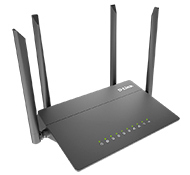 |
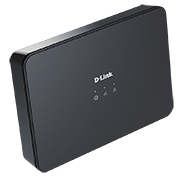 |
|
Hardware
|
||
|
Processor
|
RTL8197FH-VG (1GHz)
|
RTL8197FN (1GHz)
|
|
RAM
|
128MB, DDR2, built in processor
|
64MB, DDR2, built in processor
|
|
Flash
|
128MB, NAND SPI
|
16MB, SPI
|
|
Interfaces
|
10/100BASE-TX WAN port
4 10/100BASE-TX LAN ports
USB 2.0 port
|
10/100BASE-TX WAN port
4 10/100BASE-TX LAN ports
|
|
LEDs
|
Power
Internet
4 LAN LEDs
WLAN 2.4G
WLAN 5G
WPS
USB
|
Internet
WLAN/WPS 2.4G
WLAN/WPS 5G
WAN
4 LAN LEDs
|
|
Buttons
|
POWER button to power on/power off
WIFI button to enable/disable wireless network
WPS button to connect mesh network devices and set up wireless connection
RESET button to restore factory default settings
|
RST/WPS button to restore factory default settings and set up wireless connection
|
|
Antenna
|
Four external non-detachable antennas
|
Four internal antennas
|
|
5dBi gain
|
3.5dBi gain
|
|
|
MIMO
|
2 x 2, MU-MIMO
|
|
|
Power connector
|
Power input connector (DC)
|
|
|
Mounting
|
Desktop
Wall
|
|
|
Software
|
||
|
WAN connection types
|
|
|
|
Mobile Internet (via supported USB modem)
|
+
|
–
|
|
PPPoE
|
+
|
+
|
|
IPv6 PPPoE
|
+
|
+
|
|
PPPoE Dual Stack
|
+
|
+
|
|
Static IPv4 / Dynamic IPv4
|
+
|
+
|
|
Static IPv6 / Dynamic IPv6
|
+
|
+
|
|
PPPoE + Static IP / Dynamic IP (PPPoE Dual Access)
|
+
|
+
|
|
PPTP/L2TP + Static IP
|
+
|
+
|
|
PPTP/L2TP + Dynamic IP
|
+
|
+
|
|
Network functions
|
|
|
|
Support of IEEE 802.1X for Internet connection
|
–
|
+
|
|
DHCP server/relay
|
+
|
+
|
|
Advanced configuration of built-in DHCP server
|
+
|
+
|
|
Stateful/Stateless mode for IPv6 address assignment, IPv6 prefix delegation
|
+
|
+
|
|
Automatic obtainment of LAN IP address (for access point/repeater/client modes)
|
+
|
+
|
|
DNS relay
|
+
|
+
|
|
Dynamic DNS
|
+
|
+
|
|
Static IP routing
|
+
|
+
|
|
Static IPv6 routing
|
+
|
+
|
|
IGMP Proxy
|
+
|
+
|
|
MLD Proxy
|
+
|
+
|
|
RIP
|
+
|
+
|
| Support of UPnP |
+
|
–
|
|
Support of UPnP IGD
|
+
|
+
|
|
Support of VLAN
|
+
|
+
|
|
WAN ping respond
|
+
|
+
|
|
Support of SIP ALG
|
+
|
+
|
|
Support of RTSP
|
+
|
+
|
|
WAN failover
|
+
|
+
|
|
Autonegotiation of speed, duplex mode, and flow control/Manual speed and duplex mode setup for each Ethernet port
|
+
|
+
|
|
Setup of maximum TX rate for each port of the router
|
–
|
+
|
|
XUPNPD plug-in
|
+
|
–
|
|
Built-in UDPXY application
|
+
|
+
|
|
Firewall functions
|
|
|
|
Network Address Translation (NAT)
|
+
|
+
|
|
Stateful Packet Inspection (SPI)
|
+
|
+
|
|
IP filter
|
+
|
+
|
|
IPv6 filter
|
+
|
+
|
|
MAC filter
|
+
|
+
|
|
URL filter
|
+
|
+
|
|
Ad blocking function
|
+
|
–
|
|
DMZ
|
+
|
+
|
|
Prevention of ARP and DDoS attacks
|
–
|
+
|
|
Virtual servers
|
+
|
+
|
|
Built-in SkyDNS web content filtering service
|
+
|
–
|
|
VPN
|
|
|
|
IPsec/PPTP/L2TP/PPPoE pass-through
|
+
|
+
|
|
PPTP/L2TP tunnels
|
+
|
+
|
|
L2TP over IPsec client
|
+
|
–
|
|
IPsec tunnels
|
+
|
+
|
|
Transport/Tunnel mode
|
+
|
–
|
|
IKEv1 support
|
+
|
+
|
|
IKEv2 support
|
+
|
–
|
|
DES encryption
|
+
|
+
|
|
NAT Traversal
|
+
|
+
|
|
Support of DPD (Keep-alive for VPN tunnels)
|
+
|
+
|
|
USB interface functions
|
|
|
|
USB modem
|
|
|
|
Auto connection to available type of supported network (4G/3G/2G)
|
+
|
–
|
|
Auto configuration of connection upon plugging in USB modem
|
+
|
–
|
|
Enabling/disabling PIN code check, changing PIN code1
|
+
|
–
|
|
Sending/receiving/reading/removing SMS messages1
|
+
|
–
|
|
Support of USSD requests1
|
+
|
–
|
|
USB storage
|
|
|
|
File browser
|
+
|
–
|
|
Print server
|
+
|
–
|
|
Access to storage via accounts
|
+
|
–
|
|
Built-in Samba server
|
+
|
–
|
|
Built-in FTP server
|
+
|
–
|
|
Built-in DLNA server
|
+
|
–
|
|
Built-in Transmission torrent client; uploading/downloading files from/to USB storage
|
+
|
–
|
|
Management and monitoring
|
|
|
|
Local and remote access to settings through SSH
|
+
|
–
|
|
Local and remote access to settings through TELNET/WEB (HTTP/HTTPS)
|
+
|
+
|
|
Bilingual web-based interface for configuration and management (Russian/English)
|
+
|
+
|
|
Support of D-Link Assistant application for Android smartphones
|
+
|
+
|
|
Notification on connection problems and auto redirect to settings
|
+
|
+
|
|
Firmware update via web-based interface
|
+
|
+
|
|
Automatic notification on new firmware version
|
+
|
+
|
|
Saving/restoring configuration to/from file
|
+
|
+
|
|
Support of logging to remote host
|
+
|
+
|
|
Support of logging to connected USB storage
|
+
|
–
|
|
Automatic synchronization of system time with NTP server and manual time/date setup
|
+
|
+
|
|
Ping utility
|
+
|
+
|
|
Traceroute utility
|
+
|
+
|
|
TR-069 client
|
+
|
+
|
|
Automatic reboot on schedule
|
+
|
+
|
|
Schedules for rules and settings of firewall, automatic saving a configuration backup to a connected USB storage, limitation of wireless client maximum bandwidth, and enabling/disabling wireless network and Wi-Fi filter
|
+
|
–
|
|
Automatic upload of configuration file from ISP's server (Auto Provision)
|
+
|
–
|
|
Wireless Module Parameters
|
||
|
Standards
|
IEEE 802.11ac Wave 2
IEEE 802.11a/b/g/n
IEEE 802.11k/v
IEEE 802.11w
|
IEEE 802.11ac Wave 2
IEEE 802.11a/b/g/n
|
|
Frequency range
The frequency range depends upon the radio frequency regulations applied in your country
|
2400 ~ 2483.5MHz
5150 ~ 5350MHz
5650 ~ 5850MHz
|
|
|
Wireless connection security
|
|
|
|
WEP
|
+
|
+
|
|
WPA/WPA2 (Personal/Enterprise)
|
+
|
+
|
|
WPA3 (Personal)
|
+
|
–
|
|
МАС filter
|
+
|
+
|
|
WPS (PBC/PIN)
|
+
|
+
|
|
Advanced functions
|
|
|
|
EasyMesh function
|
+
|
–
|
|
Support of client mode
|
+
|
+
|
|
WMM (Wi-Fi QoS)
|
+
|
+
|
|
Information on connected Wi-Fi clients
|
+
|
+
|
|
Advanced settings
|
+
|
+
|
|
Smart adjustment of Wi-Fi clients
|
–
|
+
|
|
Guest Wi-Fi / support of MBSSID
|
+
|
+
|
|
Rate limitation for wireless network/separate MAC addresses
|
+
|
+
|
|
Periodic scan of channels, automatic switch to least loaded channel
|
+
|
+
|
|
Support of 2.4GHz TX Beamforming
|
–
|
+
|
|
Support of 5GHz TX Beamforming
|
+
|
+
|
|
Autonegotiation of channel bandwidth in accordance with environment conditions (20/40 Coexistence)
|
+
|
+
|
|
Support of STBC
|
+
|
–
|
|
CoovaChilli authentication portal
|
+
|
-
|
|
Wireless connection rate
|
IEEE 802.11a: 6, 9, 12, 18, 24, 36, 48, and 54Mbps
IEEE 802.11b: 1, 2, 5.5, and 11Mbps
IEEE 802.11g: 6, 9, 12, 18, 24, 36, 48, and 54Mbps
IEEE 802.11n (2.4GHz/5GHz): from 6.5 to 300Mbps (from MCS0 to MCS15)
IEEE 802.11ac (5GHz): from 6.5 to 867Mbps (from MCS0 to MCS9)
|
|
|
Transmitter output power
The maximum value of the transmitter output power depends upon the radio frequency regulations applied in your country
|
Less than 20dBm (100mW) |
2.4GHz
Less than 20dBm (100mW)
5GHz
Less than 17.5dBm (56.2mW)
|
|
802.11b
|
15dBm at 1, 11Mbps
|
16.5dBm at 1, 2, 5.5, 11Mbps
|
|
802.11g
|
15dBm at 6, 54Mbps
|
16.5dBm at 6, 9, 12, 18, 24, 36, 48Mbps
15dBm at 54Mbps
|
|
802.11n
|
2.4GHz
15dBm at MCS0/8, 7/15
5GHz
15dBm at MCS0/8, 7/15
|
2.4GHz
HT20/HT40
16.5dBm at MCS0/8~6/14
16dBm at MCS7/15
5GHz, HT20
14dBm at MCS0/8~4/12
13dBm at MCS5/13
12.5dBm at MCS6/14
12dBm at MCS7/15
5GHz, HT40
14dBm at MCS0/0~2/10
13dBm at MCS3/11~4/12
12.5dBm at MCS5/13~6/14
12dBm at MCS7/15
|
|
802.11ac
|
15dBm at MCS0, 9
|
VHT20
14dBm at MCS0~4
13dBm at MCS5
12.5dBm at MCS6
12dBm at MCS7
11dBm at MCS8
VHT40
14dBm at MCS0~2
13dBm at MCS3~4
12dBm at MCS5~6
11dBm at MCS7/8/9
VHT80
14dBm at MCS0~4
13dBm at MCS5~6
12dBm at MCS7
11dBm at MCS8/9
|
|
Receiver sensitivity
|
|
|
|
802.11a
|
-92dBm at 6Mbps
-91dBm at 9Mbps
-90dBm at 12Mbps
-88dBm at 18Mbps
-85dBm at 24Mbps
-81dBm at 36Mbps
-77dBm at 48Mbps
-75dBm at 54Mbps
|
-82dBm at 6Mbps
-81dBm at 9Mbps
-79dBm at 12Mbps
-77dBm at 18Mbps
-74dBm at 24Mbps
-70dBm at 36Mbps
-66dBm at 48Mbps
-65dBm at 54Mbps
|
|
802.11b
|
-95dBm at 1Mbps
-91dBm at 2Mbps
-90dBm at 5.5Mbps
-87dBm at 11Mbps
|
-80dBm at 1Mbps
-80dBm at 2Mbps
-76dBm at 5.5Mbps
-76dBm at 11Mbps
|
|
802.11g
|
-92dBm at 6Mbps
-91dBm at 9Mbps
-90dBm at 12Mbps
-88dBm at 18Mbps
-85dBm at 24Mbps
-81dBm at 36Mbps
-77dBm at 48Mbps
-76dBm at 54Mbps
|
-82dBm at 6Mbps
-81dBm at 9Mbps
-79dBm at 12Mbps
-77dBm at 18Mbps
-74dBm at 24Mbps
-70dBm at 36Mbps
-66dBm at 48Mbps
-65dBm at 54Mbps
|
|
802.11n
|
2.4GHz, HT20
-92dBm at MCS0/8
-90dBm at MCS1/9
-87dBm at MCS2/10
-84dBm at MCS3/11
-81dBm at MCS4/12
-77dBm at MCS5/13
-75dBm at MCS6/14
-74dBm at MCS7/15
2.4GHz, HT40
-88dBm at MCS0/8
-86dBm at MCS1/9
-84dBm at MCS2/10
-81dBm at MCS3/11
-77dBm at MCS4/12
-73dBm at MCS5/13
-71dBm at MCS6/14
-70dBm at MCS7/15
5GHz, HT20
-91dBm at MCS0/8
-90dBm at MCS1/9
-88dBm at MCS2/10
-84dBm at MCS3/11
-81dBm at MCS4/12
-76dBm at MCS5/13
-75dBm at MCS6/14
-73dBm at MCS7/15
5GHz, HT40
-90dBm at MCS0/8
-87dBm at MCS1/9
-84dBm at MCS2/10
-81dBm at MCS3/11
-78dBm at MCS4/12
-73dBm at MCS5/13
-72dBm at MCS6/14
-70dBm at MCS7/15
|
HT20
-82dBm at MCS0/8
-79dBm at MCS1/9
-77dBm at MCS2/10
-74dBm at MCS3/11
-70dBm at MCS4/12
-66dBm at MCS5/13
-65dBm at MCS6/14
-64dBm at MCS7/15
HT40
-79dBm at MCS0/8
-76dBm at MCS1/9
-74dBm at MCS2/10
-71dBm at MCS3/11
-67dBm at MCS4/12
-63dBm at MCS5/13
-62dBm at MCS6/14
-61dBm at MCS7/15
|
|
802.11ac
|
VHT20
-91dBm at MCS0
-89dBm at MCS1
-87dBm at MCS2
-84dBm at MCS3
-81dBm at MCS4
-76dBm at MCS5
-75dBm at MCS6
-74dBm at MCS7
-69dBm at MCS8
VHT40
-90dBm at MCS0
-87dBm at MCS1
-84dBm at MCS2
-81dBm at MCS3
-78dBm at MCS4
-73dBm at MCS5
-72dBm at MCS6
-71dBm at MCS7
-66dBm at MCS8
-64dBm at MCS9
VHT80
-87dBm at MCS0
-83dBm at MCS1
-81dBm at MCS2
-78dBm at MCS3
-74dBm at MCS4
-70dBm at MCS5
-69dBm at MCS6
-67dBm at MCS7
-63dBm at MCS8
-62dBm at MCS9
|
VHT20
-82dBm at MCS0
-79dBm at MCS1
-77dBm at MCS2
-74dBm at MCS3
-70dBm at MCS4
-66dBm at MCS5
-65dBm at MCS6
-64dBm at MCS7
-56dBm at MCS8
VHT40
-79dBm at MCS0
-76dBm at MCS1
-74dBm at MCS2
-71dBm at MCS3
-67dBm at MCS4
-63dBm at MCS5
-62dBm at MCS6
-61dBm at MCS7
-56dBm at MCS8
-54dBm at MCS9
VHT80
-76dBm at MCS0
-73dBm at MCS1
-71dBm at MCS2
-68dBm at MCS3
-64dBm at MCS4
-60dBm at MCS5
-59dBm at MCS6
-58dBm at MCS7
-53dBm at MCS8
-51dBm at MCS9
|
|
Modulation schemes
|
|
|
|
802.11a
|
BPSK, QPSK, 16QAM, 64QAM with OFDM
|
|
|
802.11b
|
DQPSK, DBPSK, DSSS, CCK
|
|
|
802.11g
|
BPSK, QPSK, 16QAM, 64QAM with OFDM
|
|
|
802.11n
|
BPSK, QPSK, 16QAM, 64QAM with OFDM
|
|
|
802.11ac
|
BPSK, QPSK, 16QAM, 64QAM, up to 256QAM with OFDM
|
|
|
Physical Parameters
|
||
|
Dimensions (L x W x H)
|
205 x 136 x 33 mm (8.07 x 5.35 x 1.3 in)
|
160 x 55 x 110 mm (6 x 2 x 4 in)
|
|
Weight
|
289 g (0.63 lb)
|
197 g (0.43 lb)
|
|
Operating Environment
|
||
|
Power
|
Output: 12V DC, 1A
|
Output: 12V DC, 0.5A
|
|
Temperature
|
Operating: from 0 to 40 °C
Storage: from -20 to 65 °C
|
|
|
Humidity
|
Operating: from 10% to 90% (non-condensing)
Storage: from 5% to 95% (non-condensing)
|
|
|
Delivery Package
|
||
|
|
Router DIR-815
|
|
|
Power adapter DC 12V/1A
|
Power adapter DC 12V/0.5A
|
|
|
Ethernet cable
“Quick Installation Guide” (brochure)
|
||
|
Supported USB modems2
|
||
|
GSM
|
|
|
|
Alcatel X500
|
+
|
–
|
|
D-Link DWM-152C1
|
+
|
–
|
|
D-Link DWM-156A6
|
+
|
–
|
|
D-Link DWM-156A7
|
+
|
–
|
|
D-Link DWM-156A8
|
+
|
–
|
|
D-Link DWM-156C1
|
+
|
–
|
|
D-Link DWM-157B1
|
+
|
–
|
|
D-Link DWM-157B1 (Velcom)
|
+
|
–
|
|
D-Link DWM-158D1
|
+
|
–
|
|
D-Link DWR-710
|
+
|
–
|
|
Huawei E150
|
+
|
–
|
|
Huawei E1550
|
+
|
–
|
|
Huawei E156G
|
+
|
–
|
|
Huawei E160G
|
+
|
–
|
|
Huawei E169G
|
+
|
–
|
|
Huawei E171
|
+
|
–
|
|
Huawei E173 (Megafon)
|
+
|
–
|
|
Huawei E220
|
+
|
–
|
|
Huawei E3131 (MTS 420S)
|
+
|
–
|
|
Huawei E352 (Megafon)
|
+
|
–
|
|
Huawei E3531
|
+
|
–
|
|
Prolink PHS600
|
+
|
–
|
|
Prolink PHS901
|
+
|
–
|
|
ZTE MF112
|
+
|
–
|
|
ZTE MF192
|
+
|
–
|
|
ZTE MF626
|
+
|
–
|
|
ZTE MF627
|
+
|
–
|
|
ZTE MF652
|
+
|
–
|
|
ZTE MF667
|
+
|
–
|
|
ZTE MF668
|
+
|
–
|
|
ZTE MF752
|
+
|
–
|
|
LTE
|
|
|
|
Alcatel IK40V
|
+
|
–
|
| Brovi E3372-325 | + | – |
|
D-Link DWM-222
|
+
|
–
|
| D-Link DWR-910 (revision D1) | + | – |
|
Huawei E3131
|
+
|
–
|
|
Huawei E3272
|
+
|
–
|
|
Huawei E3351
|
+
|
–
|
|
Huawei E3372s
|
+
|
–
|
|
Huawei E3372h-153
|
+
|
–
|
|
Huawei E3372h-320
|
+
|
–
|
|
Huawei E367
|
+
|
–
|
|
Huawei E392
|
+
|
–
|
|
Megafon M100-1
|
+
|
–
|
|
Megafon M100-2
|
+
|
–
|
|
Megafon M100-3
|
+
|
–
|
|
Megafon M100-4
|
+
|
–
|
|
Megafon M150-1
|
+
|
–
|
|
Megafon M150-2
|
+
|
–
|
|
Megafon M150-3
|
+
|
–
|
| Megafon M150-4 | + | – |
|
MTS 824F
|
+
|
–
|
|
MTS 827F
|
+
|
–
|
|
Quanta 1K6E (Beeline 1K6E)
|
+
|
–
|
|
Yota LU-150
|
+
|
–
|
|
Yota WLTUBA-107
|
+
|
–
|
|
ZTE MF823
|
+
|
–
|
|
ZTE MF823D
|
+
|
–
|
|
ZTE MF827
|
+
|
–
|
|
ZTE MF833T
|
+
|
–
|
|
ZTE MF833V
|
+
|
–
|
|
Smartphones in USB tethering mode
|
Some models of Android smartphones
|
–
|
1For some models of USB modems.
2The manufacturer does not guarantee proper operation of the router with every modification of the firmware of USB modems.
Certificates
Order info
DIR-815/R1 AC1200 Wave 2 MU-MIMO Wi-Fi EasyMesh Router with 3G/LTE Support and USB Port
DIR-815/S/S1 AC1200 Wave 2 MU-MIMO Wi-Fi EasyMesh Router with 3G/LTE Support and USB Port



